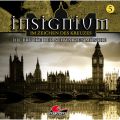 Insignium - Im Zeichen des Kreuzes, Folge 5: Die Brucke der schwarzen Monche
Insignium - Im Zeichen des Kreuzes, Folge 5: Die Brucke der schwarzen Monche
Автор: Ascan von Bargen
Год издания: 0000
Bei ihren Nachforschungen sto?en Sante della Vigna und die schone Orientalin Shirat auf den mysteriosen Logen-Mord am «Bankier Gottes». Kaum in London eingetroffen, begreifen sie auf schmerzhafte Weise, dass es Geheimnisse gibt, von denen man besser die Finger lasst. Denn irgendjemand scheint alles daran zu setzen, das ungleiche Paar zu ermorden…
 Folge der Nichteinigung
Folge der Nichteinigung
Автор: Группа авторов
Год издания:
Полный вариант заголовка: «Folge der Nichteinigung : ein Bruchstuck des Zeitalters der neueren Welt».
 Von dem Ende der Christenverfolger
Von dem Ende der Christenverfolger
Автор: Lucius Lactantius
Год издания:
Полный вариант заголовка: «Von dem Ende der Christenverfolger : aus dem lateinischen des Cacilius Lactantius Firmianus mit kritischen und erklarenden Anmerkungen / Lucius Cacilius Lactantius Firmianus».
 Turme und Brucken. Die neue Kunst des Ingenieurbaus
Turme und Brucken. Die neue Kunst des Ingenieurbaus
Автор: David Billington P.
Год издания:
Long recognised as a classic in the USA, «The Tower and the Bridge» is now at last available in German translation. In his preface to the German edition, Jorg Schlaich writes. «This book is essential reading and a pleasure for the „structural engineering artist“, in whose structures the connection between form and force flow is visible and which are distinguished by the ideals of efficiency, cost-effectiveness and elegance.» Billington founded with this book structural art as a new, independent art form, which he considers equivalent to architecture. It is no coincidence that the title states the two classic domains of the structural engineer; in this case Billington is referring to two outstanding structures of the epoch, the Eiffel Tower and the Brooklyn Bridge. Billington describes in an easily readable style and in an entertaining manner the ideals, principles and methods of structural art during its historical development through examples of structures from outstanding engineers (e.g. Telford, Maillart, Freyssinet, Menn). With the establishment of structural art as an art form and the explication of its inherent principles, Billington gives the reader well founded arguments for the aesthetic discussion of engineering structures. This also provides a basis for criticism of the new art form; for the criticism of construction that has long been demanded. This timeless book thus has the potential to give a new impulse to the debate about construction culture and particularly the aesthetic aspects of structural engineering in German-speaking countries.
 Insignium - Im Zeichen des Kreuzes, Folge 5: Die Brucke der schwarzen Monche
Insignium - Im Zeichen des Kreuzes, Folge 5: Die Brucke der schwarzen Monche
 Insignium - Im Zeichen des Kreuzes, Folge 5: Die Brucke der schwarzen Monche
Insignium - Im Zeichen des Kreuzes, Folge 5: Die Brucke der schwarzen Monche